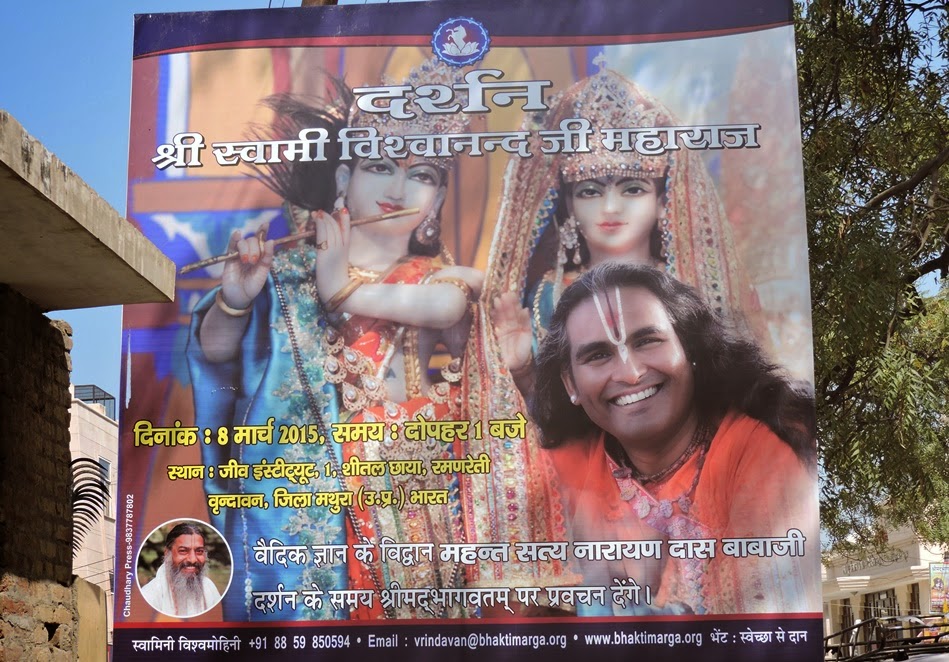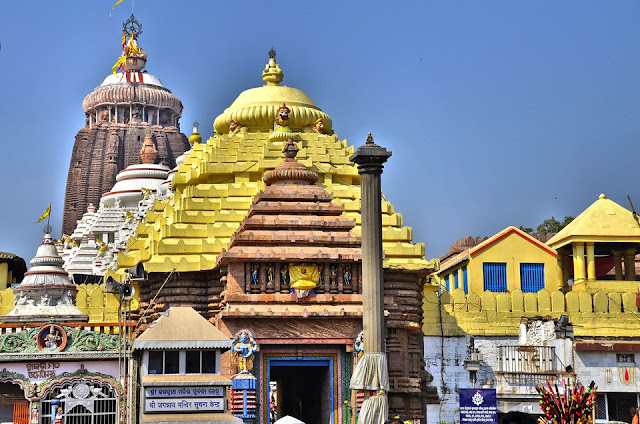Excerpt from CCMK
I just came across this little bit of translation from the sixth sarga of Chaitanya Charitamrita Mahakavya by Kavi Karnapur. It seems to have come from a bit of correspondence I was having with someone. Can't remember when this was or with whom I discussed it. So I am just posting it here for the heck of it.
The problem is the thorny one of the relation of Mayavada to Gaudiya Vaishnava theology.
adhyAtma-tattvam abhi gaura-mahAprabhuH sa
vyAkhyAM cakAra bahu-durgama-bodham anyaiH |
eko’vashiSyata ihAvirataM sa AtmA
sriSTau sa eva punar ekaka eva bhAti ||63|| itthaM prasArya sva-karau karuNA-samudro
muSTIcakAra ca punar drutam eva nrityan
sac-cit-svarUpam atha tattva-nirUpaNaM tad
bhUyo jagAda jagad eka-gatiH prakAmam ||64||
bhAvo’pi nishcitam anarthaka eva tasya
sad-rUpam eva sudhiyAm avadhAraNIyam |
yad brahmaNo bhavati naiva kadApi muktir
ekatvam etad avabodham rite hi sA syAt ||65||
pashyAngulI kara-gate punar ekakasya
seko’mritena nicitAM parilocitAM ca |
anyAM vraNena galatAtirAm avadyAM
no pashyati kshaNam api prakaTaM ghriNArtaH ||66||
Pran Krishna Goswami translates as follows:
At any rate, for me, it would seem that the argument is that there is no true spirituality without the realizations that are normally associated with Brahma-vada--namely the underlying unity of God and his creation. Those who emphasize difference throughout are ultimately deprived even of bhakti as much as those who emphasize oneness at the expense of difference.
itthaM sa eka iha sheSa-padaM hy anAdir
AtmA sadaiva parishiSyata evam eSaH |
sopAdhir eva bhavati prakaTAd upAdher
mukto’nyathA sa khalu kashchid apIha jIvaH ||67||
Your [can't remember who I was dialoging with] translation appears to be based on Pran Krishna Goswami’s Bengali translation, which I am also using.
itthaM iha sa eka sheSa-padaM hi,
evam eSa anAdiH AtmA sadaiva parishiSyata
prakaTAd upAdheH sopAdhiH eva bhavati,
anyathA sa kashcid apIha jIvaH khalu mukto [bhavati] ||
naSTe loke dvi-parArdhAvasAne
mahA-bhUteSv Adi-bhUtaM gateSu |
vyakte’vyaktaM kAla-vegena yAte
bhavAn ekaH ziSyate zeSa-saMjJaH ||
-----
kAruNyaM kuru bhagavan prabho tad asyai
yeneyaM tvayi na karoti putra-bhAvam
yeneyaM tava caraNe bhavet prapannA
tenaiva prabhavati nirvritir mamApi
The problem is the thorny one of the relation of Mayavada to Gaudiya Vaishnava theology.
vyAkhyAM cakAra bahu-durgama-bodham anyaiH |
eko’vashiSyata ihAvirataM sa AtmA
sriSTau sa eva punar ekaka eva bhAti ||63||
Gauranga Mahaprabhu then started a discourse on metaphysical topics (adhyAtma-tattva), one that was not easily understandable to ordinary people. He said, “The soul is the only thing that never comes to an end. The soul alone remains after universal dissolution, and after creation it is the soul alone that becomes manifest.”
muSTIcakAra ca punar drutam eva nrityan
sac-cit-svarUpam atha tattva-nirUpaNaM tad
bhUyo jagAda jagad eka-gatiH prakAmam ||64||
Having said this, the ocean of mercy spread his fingers as he continued to dance. Then the only refuge of the universe made his hands into fists and once again started to explain the eternal spiritual supreme in many ways.[The spreading of fingers, etc., is perhaps explained in v. 66 below.]
sad-rUpam eva sudhiyAm avadhAraNIyam |
yad brahmaNo bhavati naiva kadApi muktir
ekatvam etad avabodham rite hi sA syAt ||65||
Though this transformation as the creation (bhAvaH) is certainly without any true meaning (anarthaka eva), those whose intelligence is clear (sudhI) should know that this too is a true form of the Lord (tasya sad-rUpam eva). Without recognizing the oneness of Brahman, no one can ever attain liberation.[There appear to be several conflicting ideas in this verse. On the one hand the universe has no meaning, and then it is said to be a form of the Lord. I would assume this is an allusion to the Chatuhshloki verse. As to the last line, I recently just read something similar in Bhagavat-sandarbha, but since I will have to rummage for it, I will come back with it later.
seko’mritena nicitAM parilocitAM ca |
anyAM vraNena galatAtirAm avadyAM
no pashyati kshaNam api prakaTaM ghriNArtaH ||66||
Pran Krishna Goswami translates as follows:
Just look -- a person has two fingers, one has been sprinkled with ambrosia, the other is leprous. But he does not look at the latter with disgust, despite the leprosy. In other words, he accepts both as being a part of his body. So the sAkAravAdI should not hate the nirAkAravAdI.This conclusion is odd. In the context, it appears that ekaka = Brahman , as in v.64. So it seems that Karnapura is talking about the spiritual and material creations, or the liberated and conditioned souls. Both are parts of Brahman and therefore non-different from Brahman.
At any rate, for me, it would seem that the argument is that there is no true spirituality without the realizations that are normally associated with Brahma-vada--namely the underlying unity of God and his creation. Those who emphasize difference throughout are ultimately deprived even of bhakti as much as those who emphasize oneness at the expense of difference.
AtmA sadaiva parishiSyata evam eSaH |
sopAdhir eva bhavati prakaTAd upAdher
mukto’nyathA sa khalu kashchid apIha jIvaH ||67||
Your [can't remember who I was dialoging with] translation appears to be based on Pran Krishna Goswami’s Bengali translation, which I am also using.
In this way, that one eternal Atman will remain as shesha [i.e., this one eternal Atman will exist after the dissolution of the worlds], it is the Brahman with upAdhi (guNa) that emerges out of upadhi, otherwise that Brahman with upadhi is also called jiva."It’s a tough verse to read because of all the small words and broken up phrases; it therefore is open to interpretation. The best way seems to be to take each line as a discrete sentence. My reading is as follows:
evam eSa anAdiH AtmA sadaiva parishiSyata
prakaTAd upAdheH sopAdhiH eva bhavati,
anyathA sa kashcid apIha jIvaH khalu mukto [bhavati] ||
Thus, in this world, the one beginningless soul is to be called “sheSa” because He alone remains throughout eternity [even after universal dissolution] . With the manifestation of upAdhi, that same soul becomes conditioned (sopAdhi). Otherwise, if that upAdhi is not manifest, the occasional rare living being in this world becomes liberated.COMMENT: The entire passage seems to take a primarily advaita point of view, despite the subsequent glorification of devotion and devotional ecstasy. The essential term being explained is “sheSa”, as explained in BhP 10.3.25 (where Prabhupada’s translation and even transliteration are misleading (not asheSa, but sheSa-saMjnA), which is found in both verses 63 and 67. Liberation in #65 comes from knowing the essential oneness of creation, and in #67 from release from upAdhis.
mahA-bhUteSv Adi-bhUtaM gateSu |
vyakte’vyaktaM kAla-vegena yAte
bhavAn ekaH ziSyate zeSa-saMjJaH ||
After the lifetime of Lord Brahma, at the time of cosmic annihilation, when all the five gross elements enter into their original undifferentiated state, when the manifest enters into the unmanifest by the force of time, then You, who are known as Sesha, alone remain. (SB 10.3.25)
kAruNyaM kuru bhagavan prabho tad asyai
yeneyaM tvayi na karoti putra-bhAvam
yeneyaM tava caraNe bhavet prapannA
tenaiva prabhavati nirvritir mamApi
Advaita to Mahaprabhu during Mahaprakasha. "So be merciful to her, O Lord, O master! that she no longer thinks of You as her son, so that she surrenders to Your lotus feet. This will bring joy to not only her, but to me as well." (CCMK 5.87)



Comments